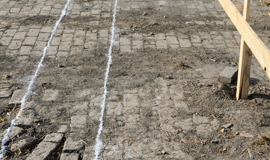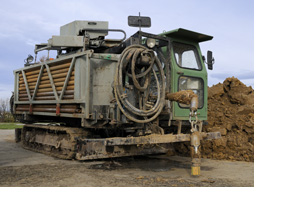| |
Using trenchless technology safely
Welcome to National Grid’s Tips of the Trade. National Grid is committed to your safety, and these tips are intended to help you work safely near our facilities. Please review these tips with your coworkers at your tailgate or toolbox meetings before work begins.
 Please help us improve our safety tips to meet your training needs. Take our two-minute survey. Please help us improve our safety tips to meet your training needs. Take our two-minute survey.
Using a directional drill, auger or other form of trenchless technology is like threading
a large needle through a maze of existing underground utilities – while blindfolded! Subterranean smarts and safe drilling practices are keys to success.
 Subterranean smarts
Notifying 811 before you dig is always essential, but you must take it a step further when you use trenchless technology:
- Inform the 811 center about your equipment. Make sure to specify you will be using directional boring/drilling technology.
- Request locator marks be placed close together. This will help you plan
for the possibility that an existing utility path might turn unexpectedly.
- Pre-mark your proposed route with white paint, flags and/or stakes.
This will help ensure the locators know your excavation area.
- Consider soil conditions. Many factors, including sandy soil or a shallow water table, will affect the depth at which you can safely drill without cave-in worries.
 Safe drilling practices
- Dig potholes and visually monitor your bore head as you cross each buried utility. If using a hydrovac, use higher flow, less pressure and a spinner tip to prevent damage to underground facilities.
- Keep a safe distance. Whether you are drilling above, beside or below a marked utility line, stay at least three feet away, plus the width of the facility. Watch as the drill head crosses utility lines during the initial bore and also during backreaming to ensure you maintain this minimum clearance.
- Calibrate. Be sure to calibrate your bore head and locating device every day and before every job.
- Don't forget the backream. Remember, your locating device will monitor the bore head on the pilot pass, but it may not be able to monitor the backream head. Plan accordingly if you have to expand the diameter of your bore before installation, and always observe the bore when crossing a buried facility during backreaming.
For more contractor safety information, visit ngridsafety.com.
|
Call 811 or enter an online request at least 72 hours before digging in Massachusetts and Rhode Island (excluding weekends and legal holidays) and at least two full working days in New York (excluding the date of your call, weekends and legal holidays).
It’s the law!
- Massachusetts and Rhode Island: digsafe.com
- Upstate New York: digsafelynewyork.com
- Metro New York, Long Island and the Rockaways: newyork-811.com
| |
To report emergencies, call 911 and National Grid immediately.
|
|
| |
In case of gas emergencies:
Long Island and the Rockaways:
911 and 1-800-490-0045
Metro New York:
911 and 1-718-643-4050
Upstate New York:
911 and 1-800-892-2345
Massachusetts:
911 and 1-800-233-5325
Rhode Island:
911 and 1-800-640-1595
|
|
In case of electric emergencies:
Upstate New York:
911 and 1-800-867-5222
Massachusetts:
911 and 1-800-465-1212
Rhode Island:
911 and 1-800-465-1212
Smell Gas. Act Fast.
|
|
|
|
|
|

